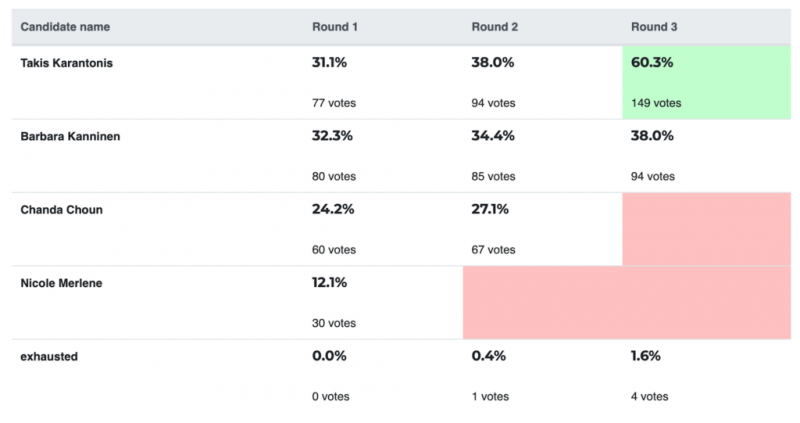Will DC’s Ward 2 special election let us see what would have happened with ranked choice voting?

I voted stickers stock photo from Barbara Kalbfleisch/Shutterstock.
While Janeese Lewis George (whom GGWash endorsed) is celebrating her victory over incumbent Brandon Todd in DC’s northern Ward 4, we still don’t know who’s going to be the Democratic nominee for Ward 2, covering Georgetown to Logan Circle. Brooke Pinto and GGWash endorsee Patrick Kennedy are separated by just 187 votes with many ballots left to count.
There’s nothing (short of a candidate filing a lawsuit, maybe) to do but wait, but voters still have yet another election coming up, a special election on June 16. Many people have already voted by mail, but many probably have not. That’s especially true based on what we saw at Tuesday’s election, where lines (of 6-foot socially-distanced voters) stretched for blocks and people were waiting at some polling places from the 8 pm poll close, already an hour past the 7 pm curfew, until midnight.
The special election will pick a councilmember to serve for the rest of this year, filling the vacancy left when former councilmember Jack Evans resigned before the council could expel him for grave ethics violations. The candidates are the same, with two exceptions. Republican Katherine Venice is on the ballot, since this special election is nonpartisan, but dropped out Thursday. And there’s Evans himself, while a candidate in the primary, decided not to try to run in the election his own resignation triggered.
Since DC has very few Republicans and Evans placed a distant 7th place out of 8 candidates, it’s not likely the difference in candidates could change the outcome. What could, however, is if some voters who supported Evans or one of the others — John Fanning, Jordan Grossman, Daniel Hernandez, Kishan Putta, or Yilin (Ellen) Zhang — vote strategically between Kennedy and Pinto.
We still don’t know for sure who got the most votes, Kennedy or Pinto (the odds are with Pinto, but it’s not for sure). More than that, we don’t know what would have happened if DC used ranked choice voting, where voters get to rank their choices. Candidates are eliminated from bottom to top, and their votes reapportioned based on the voters’ second and later choices.
Out of the votes counted so far, those who cast Hernandez’s 112 votes, Evans’ 321, Zhang’s 369, Fanning’s 599, Putta’s 890, and Grossman’s 1,898 certainly may have an opinion about whether they prefer Kennedy or Pinto. (Or, potentially, if enough voters from the lower candidates liked Grossman next, they could have propelled him into a top contender spot). Instead, all of their votes are essentially not counted, and whoever becomes the Democratic nominee and presumptive next councilmember will have won with at most 28% of the vote.
The same applies to Baltimore, where former mayor Sheila Dixon leads (as of this writing) with 31% of the vote to 25% and 17% for her next closest competitors. The results motivated the Baltimore Sun to editorialize for another system, “top two runoff,” also used in California and elsewhere. There, candidates of any party compete in an open primary and the top two, which could be from the same party, go on to the general.
In a sense, this special election could be a lower-stakes version of a top two runoff. Though it won’t affect who’s the councilmember next year, supporters of the lower candidates may decide to vote for either Pinto or Kennedy in order to sway what’s pretty likely to again be a choice between the two.
That could give us some sense, though a fuzzy one, about whether ranked choice voting could have changed the outcome of the main election. Should Pinto’s lead hold but Kennedy win by a significant margin in the special, he and his supporters could reasonably conclude he would have won in ranked-choice voting. (Or maybe not, if instead some Pinto voters rethink their choices for any reason; a tweet by reporter Andrew Giambrone reminding voters that Pinto was the only one not to support ending stop-and-frisk got considerable traction). Similarly, if the absentee ballots swing the total Kennedy’s way but Pinto puts up a stronger showing in the general, maybe that means lower-finishing candidates’ supporters preferred her.
Ranked choice voting made the difference in an Arlington ballot for county board. Takis Karantonis slightly trailed Barbara Kanninen based only on first-place votes, but he had a decisive majority for second place among supporters of the other two candidates, Chanda Choun and Nicole Merlene. Karantonis ended up with over 60% of the vote, but without ranked choice voting, Kanninen would have been elected.
Round-by-round results for the Arlington race. Images from the Arlington Democrats created with Universal Tabulator. 
This will be the umpteenth DC primary in recent years where, for better or worse, a vote split multiple ways helps one candidate but leaves supporters of the third and lower candidates effectively disenfranchised. The same dynamic is likely to play out at the November general election, where many people are running to succeed David Grosso in the seat dedicated to someone not a member of the majority party (Democrats, in DC’s case).
Grosso, as it happens, has a bill to start ranked-choice voting for the 2022 election. Perhaps the council will consider this bill this year — or they may have far more on their plate at the moment.
